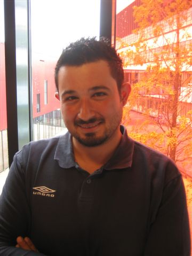Tuning brightness and oxygen sensitivity of Ru(II) and Ir(III) luminophores
Promotion date: 10. June 2011
Promotor: Prof. dr. ir. David N. Reinhoudt
Co-promotor: Dr. Aldrik H. Velders
| The design of highly bright luminophores for biological imaging still constitutes a major challenge: the necessity of conjugating a high brightness (the product of the quantum yield and the molar extinction coefficient) with a low degree of oxygen quenching (which is necessary in order to keep a high luminescence in the oxygen-rich bio-environment). Two possible strategies can be followed in order to improve the optical properties of a luminophore: the decrease of its oxygen quenching degree and the amplification of its molar extinction coefficient via multiple labeling. The first strategy is quite promising especially in order to improve the optical properties of Ir(III)-complexes, which show a pronounced oxygen sensitivity. Conversely, the brightness amplification via multiple labeling is particularly attractive for Ru(II)-complexes, which are less sensitive to oxygen quenching but show also a low emission quantum yield. In this thesis both strategies have been applied in order to realize highly bright luminescent compounds based on Ru(II) or Ir(III) complexes. Moreover, since there is only a limited amount of literature concerning the tunability of the oxygen quenching of Ir(III)-complexes, a systematic study has been conducted in order to clarify the structure-quenching relationship. |
What was the main topic of your thesis work?
After a short while, I started working on the improvement of iridium dyes which are very sensitive to oxygen. I came up with a cage-approach to protect the excited state from oxygen. The principle worked and I was able to characterize it successfully.
The last five months of the thesis period were of prime importance. First I was busy building a family of molecules possessing small differences in order to obtain a clear evidence of the structure-quenching relationship. In such a final rush I had to prove that instead of “pretty sure” the cage-approach was evidently the key-parameter. During this work it was evident that some properties which are “easy to predict” on paper, are sometimes more elusive in the real (lab) life. It has been a kind of labyrinth but finally we succeeded.
Were you able to get some nice articles published?
We had several papers published, like in Chemical Communications and in Chemistry-A European Journal. A review about oxygen quenching has been recently accepted for publication in Coordination Chemistry Review. Also we published one chapter in a book published by Wiley: Bio-inorganic Medicine Chemistry.
Are there specific skills you developed during the thesis project?
From my master project, I was quite skilled in organic synthesis. At Mesa+ I learnt about fluorescence techniques in inorganic molecules. To get acquainted with these, I followed some courses and worked with experts like Vinod Subramaniam and Luisa de Cola.
As a scientist, what do you like most?
The research freedom, I like very much, performing a lot of chemistry, try my own ideas, fabricating my own compounds using good equipment. As a little boy, I already had a little lab of my own at home.
Chemistry I perceive from an artistic point of view. The molecule I want to synthesize is like fabricating a sculpture, overcoming the synthetic difficulties to find the right molecule at the end.
What are your future plans?
I am now working as a post-doc at the École Polytechnique Fédérale de Lausanne (EPFL). Here I work on supramolecular chemisty using both organic and transition metal complexes to obtain systems which self-assemble in water. This work also involves fluorescence experiments.
The atmosphere in Switzerland is superb. A lot of interaction exists between chemists from different disciplines. Here at Mesa+ this was a lot more difficult, because always the same people appeared. Chemistry was a good tradition at Mesa+ but now they are losing it. That is a shame, in my opinion.
What, in your opinion, is important for Mesa+ to stay successful in the future?
The main focus within Mesa+ is on nanotechnology and less and less chemistry is involved. In my opinion, if one wants to work on nanoscale successfully, chemistry is a very useful ally to fabricate new nanosystems, working with the so called bottom-up approach. I am very surprised the supramolecular group (SMCT) disappeared, and no successor was found, although really good candidates showed up. In my opinion, this was not a clear process.

